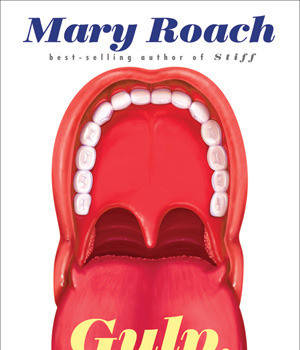Writer Mary Roach has made an art of science evangelism: her books “Bonk” (about sex) and “Stiff” (cadavers) both became bestsellers. Mary’s latest effort is “Gulp: Adventures of the Alimentary Canal,” which shines a light on the dark spaces where we process food. Mary schools Brendan in several of its fascinating factoids…including saliva-salves, blushing stomachs, and mega-colons.

Brendan Francis Newnam: Your new book is called “Gulp: Adventures on the Alimentary Canal,” and at one point in this book, a scientist describes humans as “highly-evolved earthworms surrounding the intestinal tract.” Do you consider that the book’s thesis statement?
Mary Roach: Yeah, that’s where it all began. We were basically a tube, with a little bit around it. At a certain point, to get to food sources elsewhere, you needed some way to get around, so you start developing limbs or some mobility-type device, you need a brain to kind of coordinate things, and the gut had a primitive nervous system. It really is kind of the most elemental chunk of the human.
Brendan Francis Newnam: So me laying around on a Sunday, like eating cold leftover risotto all day in bed, I’m basically fulfilling my role as a human being.
Mary Roach: You’re just dialing it back to the basics, yes.
Brendan Francis Newnam: Well that’s encouraging to hear.
Okay, your book takes the reader on shall we say, a nose to tail journey of the human. We don’t have time to talk about all the stops that food makes on its way thought your body, but I thought we could hit the key destinations.
So, let’s start with the mouth. You talk a lot about spit in this book. You profess to liking spit. What did you learn about saliva that makes you like it?
Mary Roach: I find spit fascinating cause it is the most reviled substance. That’s a curse, to spit on somebody. It’s the meanest, most degrading thing you could do. People think, “Oh it just moistens the stuff that you chew up so that it’s in a swallowable state” – and it does do that, but it also has antibacterial properties. Animals lick their wounds. There’s a reason for that
Brendan Francis Newnam: Even mothers who would kiss their child’s boo boo.
Mary Roach: Exactly. There’s histatins which have nerve and skin and growth factors in them. They speed wound closures. And I wanted to do, I never did this, but I was hoping that somehow, at some point I’d have two injuries, two cuts about the same size, and I was gonna lick one and not lick the other, and then see which one healed. It was on my to do list for a long time.
Brendan Francis Newnam: But it’s interesting you talk about maybe licking your wounds, which kind of sounds gross, but this is one of the methods that scientists used to use. They used to use their own tongues, their own fingers, and that takes us to the next destination, the stomach.
There’s one of the most horrifying chapters in this book is about a scientist named Beaumont and a test subject of his, St. Martin. Can you share that story?
Mary Roach: This is the year 1822 and Alexis St. Martin, he’s a fur trapper. Somebody’s gun goes off, shoots a hole in his side through his stomach, and he winds up in the hospital under the treatment of William Beaumont, an American Army surgeon. The wound doesn’t heal. Eventually, Beaumont has the idea that this stomach with a hole, kind of a door to the outside, could be useful for studying how digestion works. Specifically the gastric juices.
Brendan Francis Newnam: How can you just have a hole in your stomach permanently open. That seems like, wouldn’t you die?
Mary Roach: It’s a hole similar to the, you know, the earlobe plug. It just sort of heals up as a circular opening. It’s not an open wound.
Brendan Francis Newnam: So Beaumont would basically, with this hole, he would draw the gastric juices from St. Martin and then study them and see how they break down food. But how did St. Martin eat food and have his gastric juices working without them spilling out this hole in the stomach?
Mary Roach: He had a little stopper.
Brendan Francis Newnam: Really?
Mary Roach: Yeah, he had a little stopper, a little gauze wad.
Brendan Francis Newnam: That’s such a gross visual.
Okay, well, onto something maybe just as unpleasant. The final destination of our food journey, human waste disposal. Let’s be honest – your book is full of shit. It starts and ends with studies about human waste.
Mary Roach: Wait, it starts with shit, what’s the shit in the beginning?
Brendan Francis Newnam: In the introduction you talk about guys going and eating waste to learn about the nutrients.
Mary Roach: Bacteria grown on bacteria, yeah. But it would be grown on waste. Yeah, all right, yeah you’re right.
Brendan Francis Newnam: And it ends with scientists who use human waste to help people. Can you talk about that?
Mary Roach: You mean the fecal transplants? Yeah. A fecal transplant is something that’s been used with great success these days to treat chronic infections with something called c-dfficile, which is a bacteria that can get going in your intestines and set up housekeeping in little hard to reach places, and it’s very hard to get rid of it. It irritates the intestines, and it causes diarrhea, and it causes a lot of chronic symptoms, and it can be fatal.
And there’s a treatment that’s 90% effective and cheap, and that is to take a healthy person’s, a donor’s shit, put it a blender with some water, and you make just a kind of… it looks like coffee with low-fat milk in it, but it’s done under a fume hood, you don’t smell anything, and they use that same tube that you would to do a colonoscopy. They just have a little plunger and they kind of plunge it in there.
Brendan Francis Newnam: All right, I think we may have stepped out of the bounds of dinner party conversation.
This book is filled with so many neat facts that I think people would love to hear about, that I want to do a quick lightning round thing, where I will tell you the fact, and they you can quickly elaborate on it.
Okay? So the first one, when you blush the lining of your stomach blushes too. Is that true?
Mary Roach: It’s true. There was a guy named Tom. An entire book was written about Tom because he was fed through his stomach. He was kind of a famous case. And his doctor noticed, in fact, when Tom would blush, and apparently blushed very easily —
Brendan Francis Newnam: How can somebody be embarrassed when people are feeding you through your stomach? I mean it feels like you’re pretty comfortable with yourself.
Mary Roach: Yeah, I know. It was very sad. He ended up marrying a woman because, he said, this was a quote from Tom, he said, “She doesn’t mind the way I feed.”
Brendan Francis Newnam: And then she said he doesn’t mind how I cook.
Mary Roach: Exactly.
Brendan Francis Newnam: All right. So another one: space suits have charcoal filters.
Mary Roach: Yeah, and thank God for that, because otherwise you’ve got the fart recirculating past your face every few seconds.
Brendan Francis Newnam: And the filter filters that out. Okay, I’ll quickly move past that one.
Your ears play a part in how food tastes?
Mary Roach: Yeah! We love crunch, and there’s a study where they had people eating chips and they manipulated the sound or they changed the frequency, and people would say “oh, these chips are stale.” They were exactly the same.
Brendan Francis Newnam: All right, last one: Elvis Presley suffered from a megacolon.
Mary Roach: He did, yeah. Megacolon is a genetic condition where you don’t have nerves at the very far end of your colon, and so things don’t carried along very well, and you tend to have really killer constipation.
Brendan Francis Newnam: And you suggested that could have been how Elvis died.
Mary Roach: That’s what his doctor said and the death certificate suggests that it was fatal heart arrhythmia that came from pushing too hard on the john.
Brendan Francis Newnam: All right, Elvis has left the building. Mary Roach, thanks for what I think was sort of dinner party conversation.
Mary Roach: Thank you. Nobody ever invites me to dinner parties.


